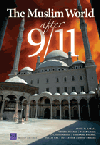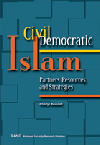
THE MUSLIM WORLD AFTER 9/11
Angel M. Rabasa et al
Pages: 564
Price: $40.00 (paperback)

CIVIL DEMOCRATIC ISLAM
Cheryl Benard
Pages: 83
Price: $20.00
Muslim World After 9/11 is the second major work on the subject coming from the prestigious US think-tank, the Rand Corporation. This is nearly three times bigger than the earlier report by Cheryl Benard, titled Civil Democratic Islam. This 564-page book has been prepared by eight experts, including Benard, and makes interesting reading.
The last one saw Muslims being of several types, the large, preponderant majority being well-meaning, peace-loving, traditional people. The second type was that of the traditional ulema, pious people who followed their religion strictly, but did not bother too much about other people's concerns. They, too, did not cause any concern, to the West. Then there were the large number of Muslims with modern (Western-style) liberal education who were influenced by Western values. By and large, they, too, did not mean any ill.
That left two more categories – the substantial number of Islamists (people associated in someway with organisations like Jamaat-e-Islami, Ikhwanul Muslimeen, Gamaa Islamia and other similar organisations). A few of them, like Jamaat-e-Islami, have been trusted allies of US foreign policy for decades in the war against communism. Now that the Cold War is over and communism has been defeated, possibly for all times to come, the US no longer feels the compulsion to be favourably disposed towards such organisations. Hence, Benard suggested that the US should now try to distance itself from Islamists and cultivate the traditionalist maulanas, sufis, and liberals.
What Benard suggested amounted to saying that the US should now distance itself from, say, an organisation like Jamaat-e-Islami (with whom it had been friendly for the last five decades or so) and move closer to people like Jamiat-ul-Ulema (with whom it was not close earlier), imams of mosques, peerzadas and sajjadanashins of dargahs and assorted sufis of different varieties, besides, of course, the Westernised Muslims. It is important to remember that not all Islamist organisations have been the favourites of the US like Jamaat-e-Islami.
That left the miniscule groups of people known differently as terrorists, insurgents, Islamic militants and fanatics. These small groups were supposed to be implacably hostile to the US and had to be dealt with firmly. Interestingly, it suggested that the US should try to distance itself from the "Wahhabis" and cultivate the Hanafis, who were supposedly more tolerant.
The present book is far more exhaustive, its focus on Muslim diaspora being a crucial part. The study finds Muslim diaspora across Western Europe and North America as both a positive influence as well as an area of risk because some of their extensive networks can potentially be used for subversion by terrorist groups.
The study takes note of similar phenomenon in the Tamil diaspora's material and moral help to Sri Lanka's Tamil Tigers (LTTE) and the Sikh diaspora's help to Khalistan separatists in Punjab. That diaspoa communities can have far-reaching impact on the world's politics is evident from the handful of American Jews influencing US policy beyond measure. Expectedly, this last diaspora community's deeds have not been mentioned.
The section on Indian Muslims is of particular interest. The major and not so major Muslim organisations are taken due note of, the Jamaat-e-Islami being mentioned as the largest of them. Organisations like All India Milli Council, Jamiatul Ulama-e-Hind and Muslim Majlis-e-Mushawarat also figure here as major organisations. It recognises the positive work of these organisations. However, the most innocuous of all Muslim organisations, the Tablighi Jamaat, comes in for some adverse mention.
It says that some individuals in this Jamaat had been caught for being in touch with international terrorists. The report suggests that Tabligh men themselves may not be inclined to terrorism, but some organisation like al-Qaeda might have planted its people in the Jamaat in view of its reach and clean record. Whatever the case, it comes as a shock to an average Indian Muslim, because this Jamaat has been known to be consistent in its apolitical stance over the last seven decades or so of its existence.
The concluding remarks about Indian Muslims are interesting. The report says that whatever involvement of a small group of Indian Muslims is established in extralegal, violent activities is largely due to a sense of insecurity produced by recurring communal riots, the state's inability to protect them, and sometimes even police siding with the rioters. Once denial of opportunity ends and equal protection of law is ensured, attraction for violent measures would wane among Muslim youth. The report pins hopes on Indian democracy to finally overcome the problem.